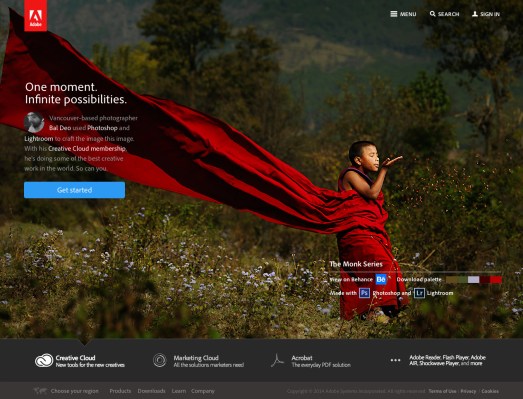Adobe announced one of its largest updates to Creative Cloud today and released its first hardware devices. But more than just launching new features for Photoshop or Lightroom, today’s update really puts the spotlight on the changes the company has been going through over the last few years since it first started to move from shrink-wrapped software to becoming a services company.
The key example for this is the launch of the Creative SDK today. This will bring many of the key features of Creative Cloud apps like Photoshop or Lightroom to third-party mobile applications. For now, the focus is just on iOS, but chances are, support for Android and maybe even desktop apps will come at some point in the future.
That by itself is a big change for Adobe, and as David Wadhwani — the company’s senior vice president and general manager of its Digital Media business unit — told me, it’s part of a large change inside the company that puts a stronger focus on services. “We are taking our 25 years of imaging and video and illustration science and starting to atomize them and make them available in the Creative SDK,” he said. “It’s a philosophical shift. It’s going to change the role that Adobe plays.”
The company’s homepage is also getting a full redesign today, which moves it away from being a marketing hub for its shrink-wrapped software and subscription services to a site where the primary call to action is simply to sign in. In the long run, Adobe also wants to power a kind of social log-in service powered by its users’ Creative Cloud identities.
“If you think about our business before, it was about driving traffic to Adobe.com and sell people a suite of products,” he said. “Now we think about us as a services company for our members.”
The launch of three separate mobile apps today is also part of this change. Wadhwani noted that this is a reflection of the fact that, on mobile, users don’t want a single app that does everything but rather small apps that focus on specialized features.
But Adobe also wants to keep its users inside its ecosystem, so it’s launching both the Creative SDK, which lets third-party developers integrate an Adobe-centric workflow into their apps and its own mobile apps, too.
Maybe even more importantly, many of the features of the mobile apps — both Adobe’s own and those powered by the Creative SDK — will use the cloud for features that need more computational power than a mobile phone can offer. This is the first time Adobe has used the cloud for actual computing.
When I asked Wadhwani about the company’s future plans for cloud computing, he noted that bringing similar features to the desktop — for compute-intensive video work, for example — would be a natural next step and something the company is looking at.
That’s a far more service-oriented model than selling shrink-wrapped software or even subscription access and it’s clearly where Adobe is going. It also sets the company up for a different business model where it can charge for these computational resources in the cloud.
The purchase of Behance was a first hint at Adobe’s shift towards a service company. Adobe made the shift to the subscription-based Creative Cloud significantly faster than most expected and it’s nicely keeping up this momentum now.
